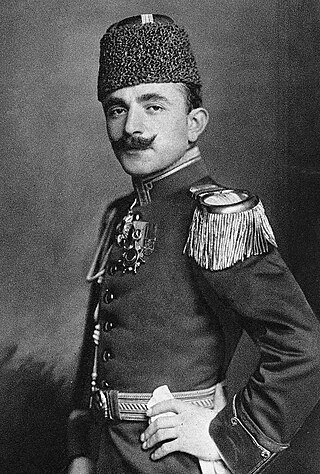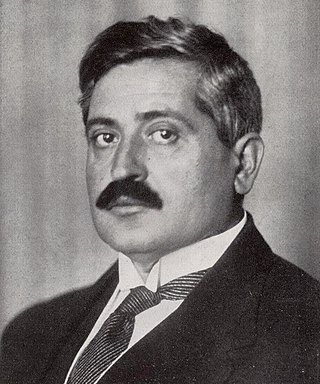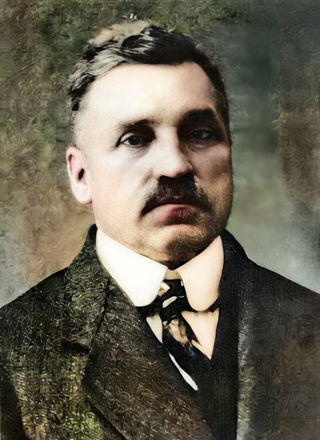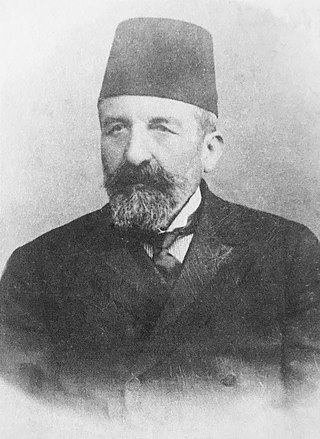Related Research Articles

The Young Turks was a constitutionalist broad opposition movement in the late Ottoman Empire against Sultan Abdul Hamid II's absolutist regime. The most powerful organization of the movement, and the most conflated, was the Committee of Union and Progress (CUP), though its goals, strategies, and membership continuously morphed throughout Abdul Hamid's reign. By the 1890s, the Young Turks were mainly a loose and contentious network of intelligentsia exiled in Western Europe and Egypt that made a living by selling their newspapers to secret subscribers.

İsmail Enver, better known as Enver Pasha, was an Ottoman military officer, revolutionary, and convicted war criminal who formed one-third of the dictatorial triumvirate known as the "Three Pashas" in the Ottoman Empire.

Mehmed Talaat, commonly known as Talaat Pasha or Talat Pasha, was an Ottoman Young Turk activist, politician, and convicted war criminal who served as the de facto leader of the Ottoman Empire from 1913 to 1918. He was chairman of the Union and Progress Party, which operated a one-party dictatorship in the Empire; during World War I he became Grand Vizier. He has been called the architect of the Armenian genocide, and was responsible for other ethnic cleansings during his time as Minister of Interior Affairs.

The Young Turk Revolution was a constitutionalist revolution in the Ottoman Empire. Revolutionaries belonging to the Internal Committee of Union and Progress, an organization of the Young Turks movement, forced Sultan Abdul Hamid II to restore the Constitution, recall the parliament, and schedule an election. Thus began the Second Constitutional Era.

The Second Constitutional Era was the period of restored parliamentary rule in the Ottoman Empire between the 1908 Young Turk Revolution and the 1920 dissolution of the General Assembly, during the empire's twilight years.

The 1913 Ottoman coup d'état, also known as the Raid on the Sublime Porte, was a coup d'état carried out in the Ottoman Empire by a number of Committee of Union and Progress (CUP) members led by Ismail Enver Bey and Mehmed Talaat Bey, in which the group made a surprise raid on the central Ottoman government buildings, the Sublime Porte. During the coup, the Minister of War, Nazım Pasha, was assassinated and the Grand Vizier, Kâmil Pasha, was forced to resign. Soon after the coup, the government fell into the hands of the CUP, now under the leadership of the triumvirate known as the "Three Pashas", made up of Enver, Talaat, and Cemal Pasha.

Ahmed Rıza was an Ottoman educator, activist, revolutionary, intellectual, politician, polymath, and a prominent member of the Young Turks. He was also a key early leader of the Committee of Union and Progress.

Mahmud Shevket Pasha was an Ottoman generalissimo and statesman, who was an important political figure during the Second Constitutional Era. During the 31 March Incident, Shevket Pasha and the Committee of Union and Progress overthrew Abdul Hamid II after an anti-Constitutionalist uprising in Constantinople. He played the role of a power broker after the crisis, balancing the various factions of the Young Turks and the army. As War Minister he played a leading role in military reform and the establishment of Air Divisions. Shevket Pasha became Grand Vizier during the First Balkan War in the aftermath of the 1913 coup d'état, from 23 January 1913 until his death by assassination.

Emmanuel Carasso or Emanuel Karasu was an Ottoman lawyer and a member of the prominent Sephardic Jewish Carasso family of Ottoman Salonica. He was also a prominent member of the Young Turks. The name is also spelled Karaso, Karassu, Karso, Karsu and Karasso. The form Karasu is a Turkification of his name, meaning literally 'dark water'. Emmanuel's nephew was the physician Isaac Carasso, also Salonica-born Sephardic Jew from the Ottoman Empire, who began producing Danone yogurt in Barcelona, Spain in 1919.

The history of the Jews of Thessaloniki reaches back two thousand years. The city of Thessaloniki housed a major Jewish community, mostly Eastern Sephardim, until the middle of the Second World War. Sephardic Jews immigrated to the city following the expulsion of Jews from Spain by Catholic rulers under the Alhambra Decree of 1492. It is the only known example of a city of this size in the Jewish diaspora that retained a Jewish majority for centuries. This community influenced the Sephardic world both culturally and economically, and the city was nicknamed la madre de Israel.
Mehmet Cavit Bey, Mehmed Cavid Bey or Mehmed Djavid Bey was an Ottoman economist, newspaper editor and leading politician during the dissolution period of the Ottoman Empire. As a Young Turk and a member of the Committee of Union and Progress (CUP) had positions in government after the constitution was re-established. In the beginning of the Republican period, he was controversially executed for his alleged involvement in an assassination attempt against Mustafa Kemal Atatürk.

The participation of Greece in the Balkan Wars of 1912–1913 is one of the most important episodes in modern Greek history, as it allowed the Greek state to almost double its size and achieve most of its present territorial size. It also served as a catalyst of political developments, as it brought to prominence two personalities, whose relationship would dominate the next decade and have long-lasting repercussions for Greece: the Prime Minister Eleftherios Venizelos, and the Army's commander-in-chief, the Crown Prince and later King, Constantine I.

The history of Freemasonry in Turkey stretches back to the 18th century under Ottoman imperial rule.

Ibrahim Starova, also Ibrahim Bërzeshta, better known as Ibrahim Temo, was an Ottoman-Albanian politician, revolutionary, intellectual, and a medical doctor by profession. Temo was the original founder of the Committee of Union and Progress (CUP).

Selanikli Mehmed Nâzım Bey also known as Doktor Nazım was a Turkish physician, politician, and revolutionary. Nazım Bey was a founding member of the Committee of Union and Progress, and served on its central committee for over ten years. He played a significant role in the Armenian genocide and the expulsion of Greeks in Western Anatolia. He was convicted for allegedly conspiring to assassinate Mustafa Kemal Atatürk in İzmir and was hanged in Ankara on 26 August 1926. He also served as the chairman of the Turkish sports club Fenerbahçe S.K. between 1916 and 1918.

Süleyman Askerî Bey, also known as Suleyman Askeri, Sulayman Askari, Sulaiman al-Askari and unofficially known as Suleyman Askeri Pasha, was a military officer who served in the Ottoman Army. Askerî was of Circassian descent and co founder of the Teşkilât-ı Mahsusa, a group involved in guerilla warfare.

Ahmed Niyazi Bey was an Ottoman revolutionary, who was the bey of the Resne area in the late 19th and early 20th centuries. An ethnic Albanian, Niyazi was one of the heroes of the 1908 Young Turk Revolution and of suppressing the 1909 countercoup as he played leading roles in both events. Niyazi is also known for the Saraj, a French-style estate he built in Resne.

The Committee of Union and Progress, refers to several revolutionary groups and a political party active between 1889 and 1926 in the Ottoman Empire and the Republic of Turkey. The foremost faction of the Young Turks, the CUP instigated the 1908 Young Turk Revolution, which ended absolute monarchy and began the Second Constitutional Era. After an ideological transformation, from 1913 to 1918, the CUP ruled the empire as a dictatorship and committed genocides against the Armenian, Greek, and Assyrian peoples as part of a broader policy of ethnic erasure during the late Ottoman period. The CUP and its members have often been referred to as Young Turks, although the movement produced other political parties as well. Within the Ottoman Empire its members were known as İttihadcılar ('Unionists') or Komiteciler ('Committeemen').

Eyüp Sabri, Ohrili Eyüp Sabri (1876-1950) known as Eyüp Sabri Akgöl after the 1934 Surname Law, was an Ottoman-Albanian revolutionary and one of the leaders of the Young Turk Revolution (1908).

Mehmet Galip Bey (1854-1915) was an Ottoman statesman who served as a Senator of the Ottoman Empire from 1908 till his death in 1915.
References
- 1 2 3 Arslan, Ozan; Ozen, Cinar. "THE REBIRTH OF THE OTTOMAN COMMITTEE OF UNION AND PROGRESS IN MACEDONIA THROUGH THE ITALIAN FREEMASONRY". Oriente Moderno: 93–115.
- ↑ Angelo Lacovella, trans. by Tulin Altinova, Gonye ve Hilal, Ittihad-Terakki ve Masonluk (II Triangolo e la Mezzaluna), Istanbul, Tarih Vakfi Yurt Yayinlari, 1998. p. 19.
- ↑ Conti, Fulvio (2008). Entre Orient et Occident. Les loges maçonniques du Grand Orient d'Italie en Méditerranée entre les XIXe et XXe siècles (in French). L'Europe Méditerranéenne. p. 120. ISBN 978-90-5201-354-1.